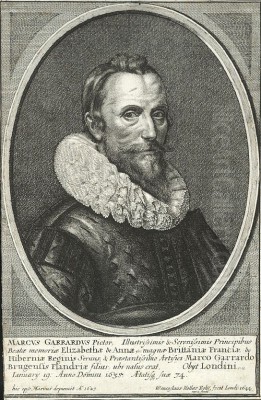
Marcus Gheeraerts the Younger stands as one of the most significant and fashionable portrait painters active in England during the late Elizabethan and early Jacobean periods. Born into an artistic dynasty in Bruges around 1561, he became a pivotal figure in the development of English portraiture, bridging the gap between the earlier Tudor styles and the burgeoning Baroque influences that would arrive later with artists like Anthony van Dyck. His life and career were shaped by the religious turmoil of his homeland and the specific demands of the English court and aristocracy for sophisticated representations of status and identity.
Gheeraerts' arrival in England was a direct consequence of the political and religious strife engulfing the Low Countries in the mid-16th century. His father, Marcus Gheeraerts the Elder, was a respected painter and printmaker in Bruges. However, as Protestants, the family faced persecution under the rule of the Duke of Alva, the Spanish governor enforcing harsh Catholic policies. Around 1568, when Marcus the Younger was approximately seven years old, he fled with his father to the relative safety of London, joining a growing community of Flemish and Dutch refugees. His mother, Johanna, remained in Bruges and sadly passed away there. This early experience of displacement undoubtedly shaped the young artist's worldview and placed him within a network of fellow émigrés who would play a crucial role in the artistic life of London.
Early Life and Artistic Formation in Exile
The artistic education of Marcus Gheeraerts the Younger likely began under the tutelage of his father, Marcus the Elder, who was himself a versatile artist known for paintings, etchings, and notably, a detailed plan of Bruges published in 1562. The elder Gheeraerts established a workshop in London, providing a natural environment for his son to learn the fundamentals of drawing, painting, and perhaps printmaking. The influence of the father's style, rooted in the Flemish tradition, would remain a foundational element in the son's work.
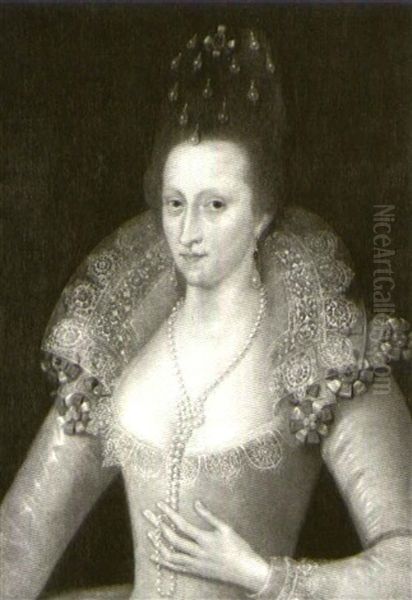
Beyond his father's instruction, it is highly probable that Gheeraerts the Younger also benefited from contact with other prominent Flemish artists working in London. Chief among these was Lucas de Heere, another Protestant refugee from Ghent, who was a painter, poet, and antiquarian. De Heere had arrived in England around the same time as the Gheeraerts family and was known for his portraits and allegorical works. Some art historians suggest de Heere may have formally taught the younger Gheeraerts, or at the very least, exerted a significant influence through his workshop and artistic circle. De Heere himself had connections to the broader Netherlandish tradition, having possibly studied under Frans Floris, linking Gheeraerts indirectly to the mainstream Antwerp school.
Another potential, though less certain, influence mentioned by some sources is Frans Pourbus the Younger, a prominent portraitist based in Antwerp. While direct tutelage is unlikely given Pourbus's location, Gheeraerts would certainly have been aware of his work and the prevailing styles emanating from Antwerp, the dominant artistic centre of the Low Countries. By the mid-1580s, Gheeraerts the Younger was establishing himself as an independent artist in London, ready to make his mark. He officially became a professional painter around 1586.
Ascendancy in the Elizabethan Court
The late 1580s and 1590s marked Gheeraerts the Younger's rise to prominence. He began to attract significant patronage from the English aristocracy and figures connected to the court of Queen Elizabeth I. A key early patron was Sir Henry Lee of Ditchley, the Queen's Champion, a role involving ceremonial duties at court. Lee commissioned several works from Gheeraerts, the most famous being the iconic 'Ditchley Portrait' of Queen Elizabeth I, painted around 1592.
This large-scale portrait is a masterpiece of Elizabethan symbolism and artistic skill. It depicts the Queen standing on a map of England, her feet resting on Oxfordshire, near Lee's estate at Ditchley. The background contrasts stormy skies on one side with sunshine on the other, likely alluding to the Queen's power to bring peace and prosperity. The painting is renowned for its meticulous rendering of the Queen's elaborate white dress, rich jewels, and the almost mask-like, iconic representation of the aging monarch's face, conforming to the idealized image she cultivated. The Ditchley Portrait cemented Gheeraerts' reputation as a painter capable of producing grand, symbolic statements of power and status, perfectly suited to the tastes of the Elizabethan elite.
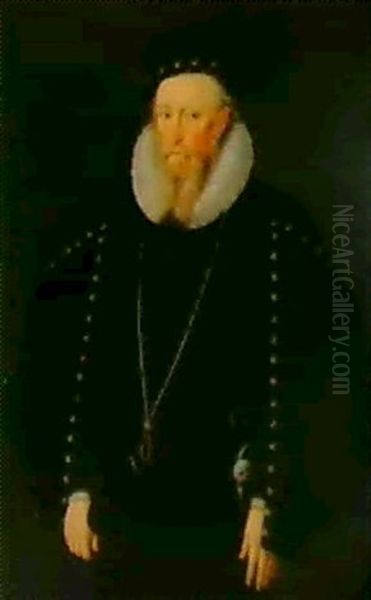
During this period, Gheeraerts' style evolved, moving beyond the tighter handling sometimes seen in earlier Flemish work towards a slightly more relaxed, yet still highly detailed, approach. He excelled at capturing the textures of luxurious fabrics – silks, satins, lace, and embroidered materials – which were crucial indicators of wealth and rank. While perhaps not achieving the deep psychological penetration of later masters, his portraits conveyed a sense of presence and individual character that appealed greatly to his patrons. His work offered a sophisticated, large-scale alternative in oil to the intimate art of the miniature, dominated at the time by Nicholas Hilliard and his talented pupil and rival, Isaac Oliver.
His personal life also intertwined with the London art world. In 1590, Marcus Gheeraerts the Younger married Magdalena de Critz. She was the daughter of Troilus de Critz, a goldsmith from Antwerp, and the sister of John de Critz, who would become a prominent painter himself, eventually holding the prestigious post of Serjeant Painter to the King. Interestingly, Marcus Gheeraerts the Elder had, after his first wife's death, married Susanna de Critz, Magdalena's sister. This complex web of family ties placed Marcus the Younger firmly within a leading Anglo-Flemish artistic dynasty, facilitating access to patronage and collaborative opportunities.
The Foremost Painter of the Jacobean Era
With the death of Queen Elizabeth I in 1603 and the accession of King James VI of Scotland as James I of England, Gheeraerts the Younger successfully navigated the transition between reigns. He quickly gained favour with the new Stuart court, particularly with James's consort, Anne of Denmark. For roughly the first decade of the Jacobean era, Gheeraerts was arguably the most fashionable painter for large-scale portraits, receiving numerous commissions from the royal family and the highest echelons of the aristocracy.
He painted several portraits of Queen Anne, often depicted in elaborate hunting attire or court dress, reflecting her interests and status. He also painted King James I, their son Henry Frederick, Prince of Wales (until the prince's untimely death in 1612), and their daughter, Princess Elizabeth, later Queen of Bohemia. These royal commissions solidified his position at the apex of the London art scene. His workshop likely expanded to meet the demand, employing assistants to help with drapery and backgrounds, a common practice at the time.
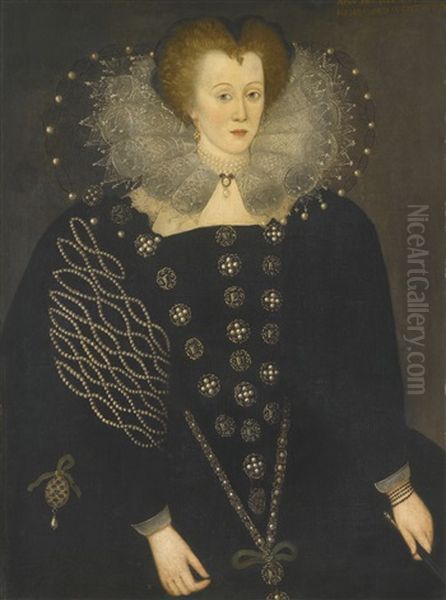
His style during this period continued to refine the characteristics developed under Elizabeth. Full-length portraits became increasingly popular, allowing for the display of opulent clothing and symbolic settings. Works like his Portrait of a Woman in Red (c. 1620, Tate Britain) exemplify his mature Jacobean style, showcasing exquisite detail in the costume, a confident pose, and a rich, atmospheric setting. He also painted prominent courtiers and figures such as Robert Devereux, 2nd Earl of Essex (though the dating of some Essex portraits is debated) and potentially earlier, the famous explorer Sir Francis Drake (a portrait dated 1594 is attributed to him).
However, Gheeraerts was not without competition. His own brother-in-law, John de Critz the Elder, shared the role of Serjeant Painter with Robert Peake the Elder from 1607. Peake was another established portraitist who also received royal commissions. William Segar, primarily known as a herald (Garter King of Arms), also painted portraits during this period. Despite this competition, Gheeraerts' distinctively elegant and detailed style remained highly sought after, defining the visual representation of the Jacobean elite in the early years of the reign.
Artistic Style, Technique, and Innovation
Marcus Gheeraerts the Younger's artistic style represents a synthesis of his Flemish heritage and the specific requirements of his English clientele. His grounding in the Netherlandish tradition, likely absorbed from his father and potentially Lucas de Heere, provided him with a mastery of realistic representation, particularly in rendering textures and details. This meticulousness was highly valued by patrons eager to see their wealth and status accurately depicted through their attire and adornments.
Compared to some of the flatter, more hieratic portraits of the earlier Tudor period, such as those by Hans Eworth (another influential Netherlandish painter working in England decades earlier), Gheeraerts introduced a greater sense of three-dimensionality and naturalism. His figures occupy space more convincingly, often set against detailed backgrounds featuring rich carpets, curtains, or glimpses of landscape. He favoured the full-length or three-quarter length format, which allowed for a full display of costume and a more imposing presence.
A significant technical innovation associated with Gheeraerts and his contemporaries working in England was the increasing use of canvas as a support for large-scale portraits, gradually replacing the traditional wood panel favoured in earlier Netherlandish painting. Canvas offered practicality for larger formats and potentially allowed for a slightly freer handling of paint, although Gheeraerts' technique generally remained precise and controlled.
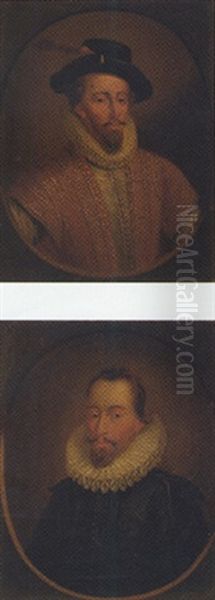
While praised for his realism in depicting surfaces and likenesses, Gheeraerts' work is sometimes seen as lacking the profound psychological depth and dynamic brushwork that would characterize the portraits of Anthony van Dyck, who arrived in England later and revolutionized court portraiture. Gheeraerts' figures often possess a certain reserved or formal quality, reflecting the decorum of the court. Yet, within these conventions, he subtly captured individual character and conveyed the sitter's social standing with great skill. His use of symbolism, inherited from Elizabethan tradition, continued in his Jacobean work, with objects, jewels, or settings often carrying specific meanings related to the sitter's lineage, virtues, or allegiances. The influence of the broader Antwerp school, with its rich colours and sophisticated compositions, is evident throughout his oeuvre.
Printmaking Activities and the Bruges Map Clarification
Beyond his primary focus on painting, Marcus Gheeraerts the Younger was also involved in the world of printmaking, like his father. The snippets mention his involvement in engravings, which were widely circulated. He likely produced designs or preparatory drawings that were then engraved by specialist printmakers, a common form of collaboration that helped disseminate images and artistic styles across Europe. Evidence suggests collaborations, possibly including designs for engravers like Theodore de Bry, a prominent publisher and engraver also active in London for a time.
It is crucial, however, to address the potential confusion regarding the famous 1562 map of Bruges, which is sometimes anachronistically linked to Marcus the Younger in less precise accounts. This highly detailed and celebrated work of cartography and engraving was definitively created by his father, Marcus Gheeraerts the Elder, before the family's flight to England. While Marcus the Younger did engage in printmaking and may have inherited skills from his father, his primary contribution and fame rest firmly on his career as a portrait painter in England, not on large-scale cartographic projects like the Bruges map.
Later Career and Shifting Tastes
By the late 1610s, the artistic landscape in London began to change. New talents arrived from the Continent, bringing fresh stylistic approaches that started to eclipse Gheeraerts' established manner. Paul van Somer, who arrived from Antwerp around 1616, introduced a more fluid and perhaps more overtly Baroque style that quickly found favour, particularly with King James I. Daniel Mytens, arriving from The Hague around 1614, offered a sophisticated and sober realism that also appealed greatly to the court and aristocracy.
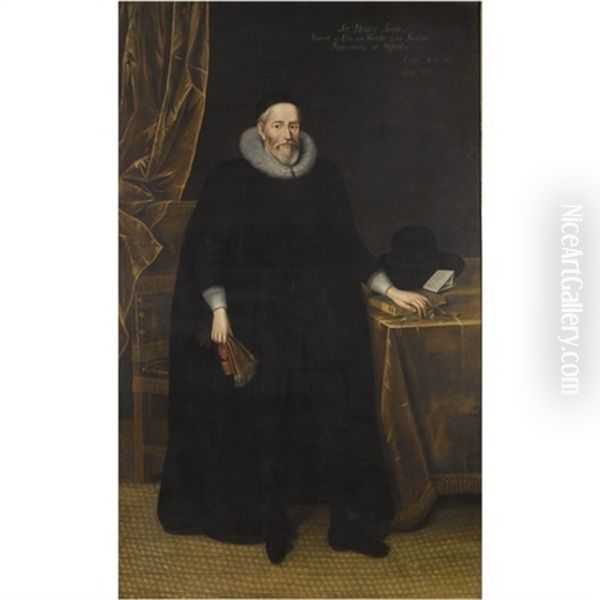
As these artists gained prominence, Gheeraerts' style, once the height of fashion, began to appear somewhat conservative or even archaic to some patrons. His commissions from the very highest levels of the court, especially after the death of his key patron Queen Anne in 1619, seem to have declined. While he continued to work and receive commissions from gentry and established aristocratic families, he was no longer the dominant force he had been. The rise of Cornelius Johnson (Cornelis Janssens van Ceulen), another skilled portraitist of Dutch extraction working in England from around 1618, further increased competition.
The ultimate shift in taste came with the reign of Charles I (from 1625), who was a far more discerning and ambitious art collector than his father. Charles actively sought out leading European artists, favouring the sophisticated realism of Mytens initially, and then wholeheartedly embracing the dynamic Baroque style of Anthony van Dyck, who settled definitively in England in 1632 and transformed English portraiture. By this time, Gheeraerts the Younger was an elderly artist whose style belonged to a previous era. He died in London on January 19, 1636, and was buried in his parish church of St. Andrew Undershaft.
Legacy and Art Historical Significance
Despite the decline in his final years, Marcus Gheeraerts the Younger occupies a crucial and honourable place in the history of British art. For over two decades, spanning the end of Elizabeth I's reign and the beginning of James I's, he was the leading painter of large-scale portraits in England. He successfully translated his Flemish artistic training into a style that met the specific needs of the English court and aristocracy, creating enduring images of the key figures of his time.
His work represents a significant step away from the flatter, more linear styles of some earlier Tudor portraiture, introducing greater naturalism, richer textures, and more complex compositions. He played a key role in popularizing the full-length portrait format in England and in the transition from panel to canvas for large works. His meticulous attention to costume detail makes his paintings invaluable historical documents for the study of fashion and material culture of the period.
Gheeraerts serves as an essential link between the Netherlandish artists who found refuge and work in Tudor England, like Hans Eworth and Lucas de Heere, and the full-blown Baroque portraiture introduced by Van Dyck. While perhaps lacking Van Dyck's psychological acuity or painterly bravura, Gheeraerts established a standard of sophisticated, elegant, and detailed representation that defined English court portraiture for a generation. His influence can be seen in the work of numerous contemporary and slightly later English painters. His portraits remain iconic representations of the Elizabethan and Jacobean elite, preserving the likenesses and capturing the atmosphere of a pivotal era in British history.
Conclusion
Marcus Gheeraerts the Younger's career exemplifies the fruitful, though sometimes challenging, interaction between Continental European artists and English patrons. Forced from his native Bruges by religious persecution, he forged a highly successful career in his adopted homeland, rising to become the pre-eminent portrait painter during a period of significant cultural and political transition. Through works like the Ditchley Portrait and his numerous depictions of Jacobean royalty and nobility, he defined the visual identity of the English elite for decades. His mastery of detail, sophisticated compositions, and ability to convey status and presence ensured his popularity. Though eventually superseded by newer styles, Marcus Gheeraerts the Younger's contribution to the development of British portraiture remains undeniable, leaving behind a rich legacy of works that continue to fascinate and inform our understanding of the Elizabethan and Jacobean worlds.